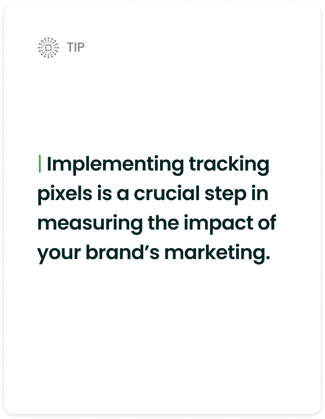3. Actionable insights ![]() 4. Pixels & performance marketing
4. Pixels & performance marketing ![]() 5. Driving awareness
5. Driving awareness
Pixel firing & performance marketing
With a clear understanding of your shoppers’ behavior across various channels, you can enhance both onsite and offsite customer engagement, driving stronger connections with your audience and boosting sales. If you missed this, go back or click here.
This section delves into the critical role marketing pixels play in targeting retail ecommerce shoppers. Learn how platforms like Pear can harness performance marketing techniques and strategic improvements to turn retail into a thriving and impactful digital marketing platform.

| THE IMPORTANCE OF PIXEL SIGNALS
Marketing pixels are some of the main characters in digital marketing strategies, acting as invisible, yet powerful, data collectors.
All major ad platforms offer unique, session-level tracking pixels for brands. These tracking pixels capture data on user engagement within a “session,” or a single website visit. Each time a visitor lands on a website, landing page, or shoppable tool embedded with a tracking pixel, their actions–such as page loads, clicks, and retailer visits–are recorded as part of that session. This lets marketers track performance and behaviors in real-time and understand engagement, preferences, and effectiveness.
Implementing tracking pixels into your shoppable tools is a crucial step in measuring the impact of a brand’s marketing. Without them, brands operate blindly when it comes to their digital efforts. They are missing out on data-inspired opportunities that get real results. DTC brands have been using pixels to their advantage for years. Omnichannel CPGs in the retail space can now harness pixels to refine their campaign strategies as well.
Pear gives CPGs the ability to embed major ad platforms’ tracking pixels into the brands’ shoppable tools–e.g. Store Locator, Shoppable PDPs, Shoppable Recipes, Landing Pages, Direct-to-Cart links, and Pear Connect–and relay pixel signals along the retail ecommerce funnel back to advertising platforms. This creates a pool of information about users’ interests and behaviors. These funnel steps include:
- Page load: A consumer explores your shoppable tool to view available retailers
- Retailer visit: A shopper visits your product on a retailer’s site
- Add-to-cart: When a shopper clicks a retailer that allows automatic carting
*Note: Since not all retailers allow this, ATC metrics don’t reflect the full add-to-cart rate for a campaign. ATC and retailer visit metrics essentially represent the same action—a shopper clicking a link—while both indicate active purchase consideration. -
Purchase: Conversion sales data relayed from 40+ major retailers
*Note: This data is only available for campaigns integrated with our partner retailers. Without an accurate shoppability provider like Pear, brands lose conversion insights.
Brands can build audiences of retail ecommerce shoppers based on these actions, and use the platforms’ machine learning for automatic optimizations.
| BUILDING & UTILIZING AUDIENCES
Once a brand's pixels are embedded into their shoppable tools, marketers can leverage the data returned to their ad platforms to create and segment custom audiences. This allows CPGs to target top, middle, and bottom-funnel shoppers with precision, accelerating campaigns.
For example, you can access:
-
A high-intent audience who visited the Store Locator page
-
An audience of users who selected Target as a retailer from a brand’s shoppable tool(s)
-
An audience who visited a retailer without purchasing (abandoned cart)
-
An audience of users who’ve already purchased/frequently purchase a brand’s products
-
& more…
Creating custom audiences tailored to a brand, retail partners, or specific actions enables more precise targeting. You can find similar users on digital platforms with pixel data. Lookalike audiences share traits with current shoppers, making them more likely to be interested in similar products. Brands using Pear’s audiences can create lookalike profiles for paid social and search campaigns, driving engagement and improving efficiency.
Pixels also enable retargeting, showing ads to users who’ve already interacted with a website or product, keeping the brand visible, and increasing conversions. By integrating all ad network pixels into Pear-powered experiences, brands can easily build retargeting audiences on their ideal platforms for highly relevant campaigns.
| APPLYING PERSONALIZED OPTIMIZATIONS
Pixels reveal what works and what doesn’t. By tracking user interactions, pixels provide valuable insights into ad performance. This data helps brands optimize content, placement, and targeting to achieve results.
CPG brands can leverage their ad platforms’ advanced machine learning optimizations to enhance campaign performance—without any added cost. Combined with access to retail ecommerce audiences, this approach enables smarter marketing budgets and data-driven decisions. The result? Effectively capturing shoppers at every stage.
Discover how Amylu increased add-to-cart rates by 10x with optimized awareness campaigns in this case study.
We encourage our partners to improve their marketing strategies with pixel visibility.
Read on as we explore the next steps to capturing a greater digital share of wallet at retail: Awareness. ![]()



